

How to Organize a Desk Without Drawers
Are you feeling constrained by your drawerless desk, struggling to find a spot for your stuff on your desk without drawers?
Do you want to discover ingenious ways to organize your desk without drawers and create a clutter-free, stylish, and highly functional workspace?
You'll learn how in this post.
If you don’t have a lot of room in your house or apartment, it can be quite difficult to create space for a desk, let alone a large desk with drawers and lots of storage space.
In any case, a desk without drawers can create a messy workspace if you don't have good desk storage solutions.
The good news is that you don't need a chest of drawers on your desk to store all your stuff - you just need to learn how to maximize the space you already have.
That's exactly what this post is all about.
You'll learn how to evaluate your current desk space, take inventory of what you need and what you can discard, determine the best layout for your desk and adopt desk storage solutions.
Benefits of Organizing a Desk Without Drawers
1. Greater Visibility
Using drawers to store office supplies and other necessary work items makes it difficult to keep track of everything you have since they are locked up away from your immediate line of sight.
You know what they say "Out of sight, out of mind.'' (its not always true though)
By organizing a desk without drawers, you'll have greater visibility into what you have and where it is. This can help reduce stress and increase productivity, as you won't have to spend time searching for things you need.
2. Less Clutter
Drawers have the tendency of quickly becoming a catch-all for clutter, leading to a disorganized mess that's often difficult to sort through.
By organizing your desk without drawers, you'll be forced to be more intentional about what you keep on your desk. This can help reduce clutter and make it easier to focus on the task at hand.
3. More Flexibility
Organizing a desk without drawers can give you more flexibility in how you use your desk. Having drawers can limit your ability to try new storage options.
Without drawers limiting your options, you can experiment with different layouts and storage solutions to find what works best for you.
This can help you create a desk setup that's tailored to your unique needs and preferences.

How to Organize a Desk without drawers Step-by-Step
Now let’s talk about the steps you can take to organize your drawerless desk.
1. Evaluate Your Desk
To organize a desk without drawers in an efficient way, the first step is to assess your desk space and identify potential problem areas.
Begin by taking inventory of what you need on your desk and what you can discard or store away from your desk. The more you can eliminate, the less cluttered your desk will be.
Once you have decluttered, determine the best layout for your desk. Think about where you will place items you use frequently and where you will store items that you use less often.
2. Implement a Desk Organization technique
The next step after decluttering your desk is to implement a desk organization technique that will help you organize your desk more efficiently today and always.
There are a number of desk organization techniques that can help you organize your desk without drawers.
You should go through each technique, pick the one that resonates more with you and go ahead and put it to practice.
You can always bookmark this blog post and come back to try out another technique on the list at anytime.
A. The KonMari Method
Made popular by Marie Kondo, the KonMari Method involves organizing your stuff by category.
Start by grouping items together (documents together, pens, pencils, and markers together, paper clips together, etc) and then choose a spot for each category on your desk.
Depending on how often you use pens and pencils or paper clips during your work, you can place them on the side of your desk of your dominant hand.
Storing everything in the same category in the same place gives you quick access to what you need and lets you see at a glance how much you have.
B. The Eisenhower Matrix
This one is not exactly a desk organization technique but its a very handy tool that can be applied to desk organization.
The Eisenhower Matrix is a tool for prioritizing tasks based on urgency and importance, especially useful for time and project management.
You can use an adapted version of this matrix to decide what will stay on your desk and what will not. You can download a copy of the matrix here.
Once you have filled in the matrix, place important and urgent items (items you use everyday e.g laptop, mouse, etc) at the center of your desk.
Then place important but not urgent items (items you might need everyday e.g headset, pens, etc) at the side of your desk of your dominant hand (easy to reach).
The items that are urgent and not important (you don't need them but you like to have them e.g. plant, photo frame, etc) can go to the other side of your desk.
And finally, the items that are not urgent and not important you can put in a storage box or discard.
C. Trinity Desk System
Another technique to organize a desk without drawers is to divide your desk into thirds. A general rule is to use a third for your daily activities, usually as laptop space.
Use a third of the desk space for things you use on a daily basis, like pens, files, paper clips or other things you need, and finally reserve the end of the desk for longer items that you might not use often.
This technique is especially good if you have a larger desk that has enough space in each third to store your office supplies.
Looking for a quick way to organize your desk without drawers?
Our Eco-friendly and multifunctional desk organizer was specially designed for you. It maximizes your desk space, enhances organization, and streamlines your work flow.
3. Get your personal belongings off your desk
Having too many personal items in on your desk can take up a lot of space on your desk. By keeping your desk clear of non-work-related items, you'll find that you have enough space for essential work supplies.
One of the first things you always have to do to maximize desk space is to remove all non-essential personal stuff from your desk, think water glasses, those old food bowl boxes you use at work.
If you do have personal belongings you'll like to keep, say, a family photoframe, etc., then designate a specific area on your desk for them.
By allocating a separate zone for personal belongings, you maintain a clutter-free workspace while still having cherished items nearby.
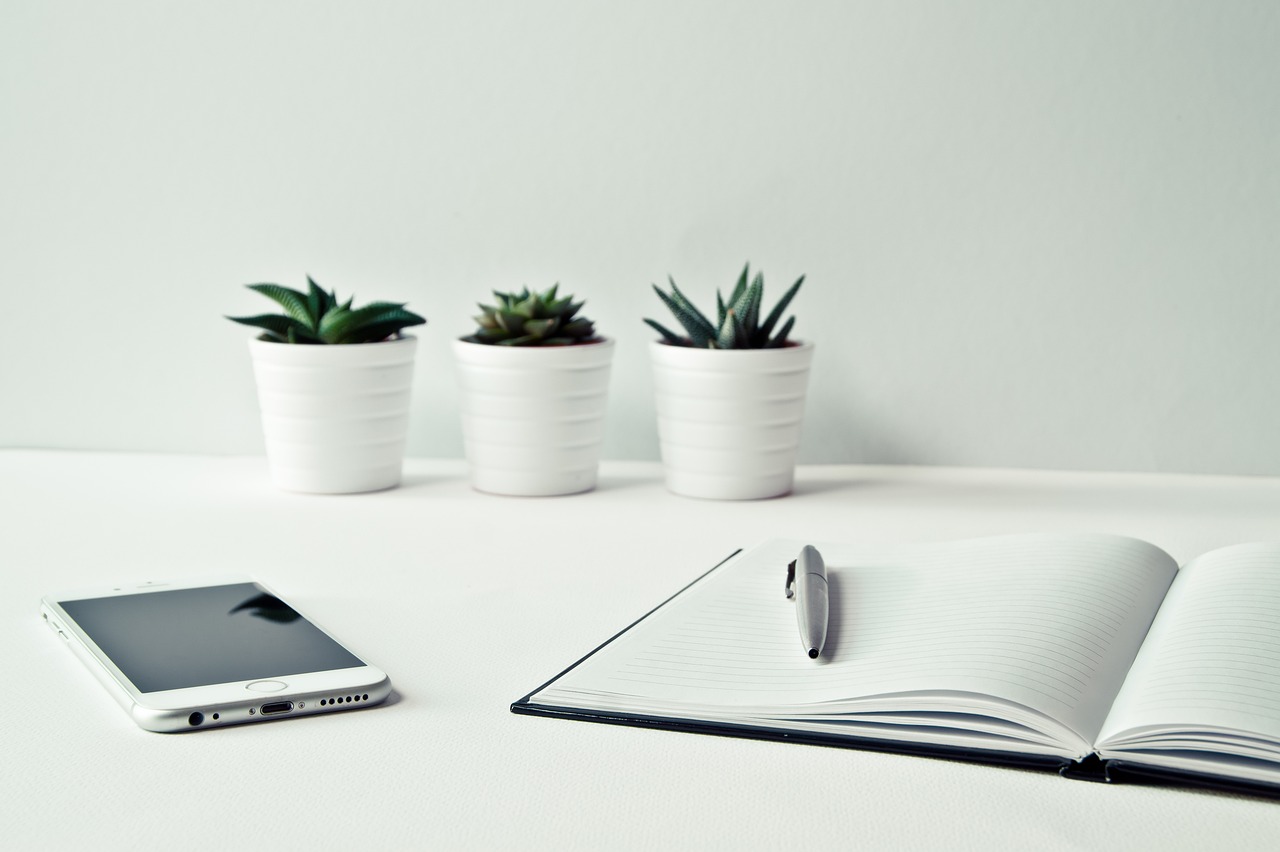
4. Digitize Your Documents and Notes
Another way to maximize the space on your desk without drawers is to reduce the amount of paper you keep on your desk.
Paper can be one of the biggest mess makers in a home office or any office for that matter. You will find it much easier to keep your desk tidy when there is very little paper on it.
Scan your documents and notes and upload them to your computer or in the cloud. Look around your home office, and you'll probably find that there are piles of loose papers that you don't use every day. Digitize them!
You may not digitize those documents that are required to be in physical form.
When you digitize papers, documents, and notes, you reduce the need for physical storage on your desk. Cloud-based solutions can even help you better organize and access your files effortlessly.
5. Use Shelves and Wall Organizers
When you don't have drawers to store thin
gs in, you can get creative and make use of other storage solutions. One great option is to use wall space for storage.
You can buy and install a wall-mounted shelf, hooks or cabinets, to keep all your office essentials organized and beautifully displayed.
Wall shelves or organizers can be used to organize everything but they are most practical for organizing items like files, picture frames, vases and small decorative pieces. They come in different sizes and shapes to suit different needs and preferences.
One thing to keep in mind when picking a wall organizer is to pick one that will allow your supplies to be within reach. You don't want to place a high shelf above your desk where you can't access it when you need it.
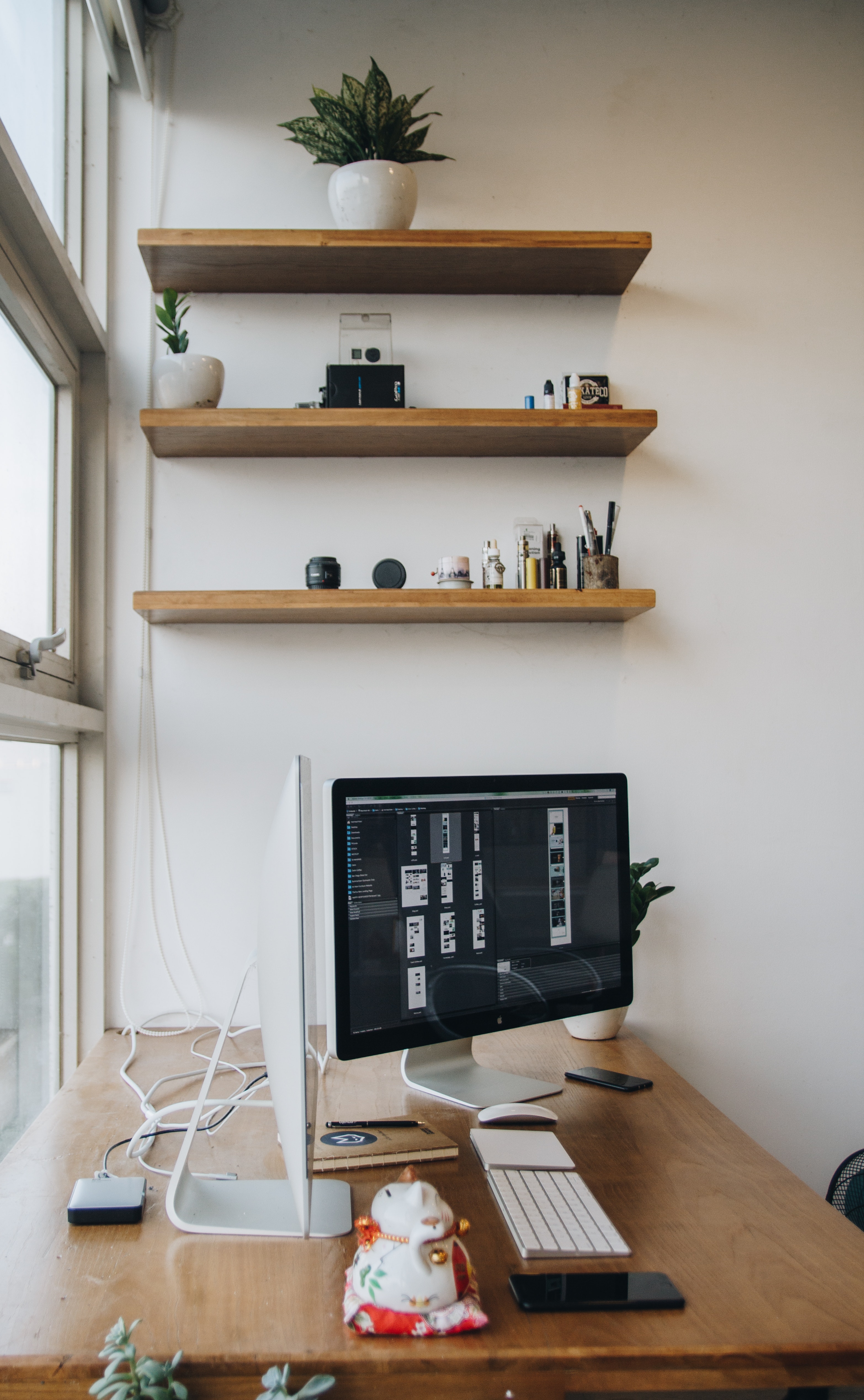
Photo by Tranmautritam
6. Get a Desk Organizer
Desk organizers can be a great way to keep your desk surface organized without the use of drawers.
Use desk organizers to keep frequently used items, such as books, notepads, staplers, paper clips, tape dispensers, pens, etc., in one place.
You can use a desk organizer with separate stationery slots to keep your items in categories as mentioned earlier.
There are many options to choose from, so think about what you need to store and find one or more that fit your needs. You can also position them in different ways to give you different storage options.
They are ideal for you if you can't (your desk might not be next to a wall) or don't want to break through walls to install a wall organizer.
Most desk organizers are easy to install (some don’t require installation) and don't even need to be attached to your desk.
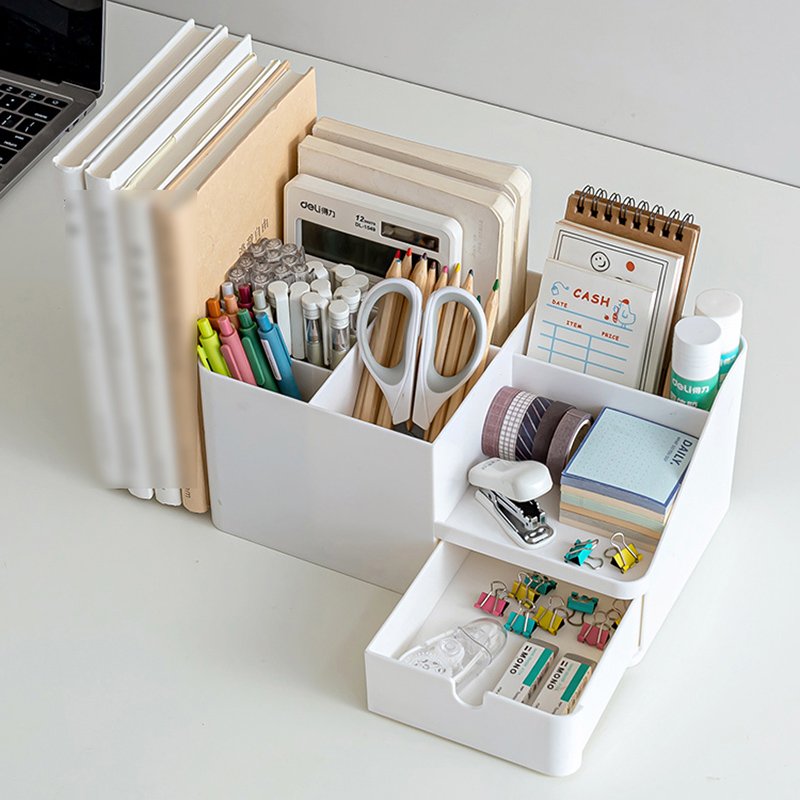
7. Use the Edge of Your Desk
Unless your desk is wedged into a tight corner, you can use the edges to your advantage. You can install a hanging desk organizer on the edge of your desk to hold everything from coffee mugs to paint brushes.
Some people don't like things hanging on the side of their desk. That's fair enough, but just be aware that you can make every inch of your desk work for you.
Attach or tape a few small hooks to the end of your desk and you'll have room for charging cables, headphones, or earbuds, and any other cables you might need.
This can make your desk look tidier as a desk can often look messy due to the back cords.
Rails are another great way to expand your storage space. Yout can firts attach a piece of tape to a side of your you prefer and then hang a pot or stand on the tape.
With this, you'll have space to store pens, pencils, brushes, and the likes. These pots can be very useful for creative activities as you can clearly see what you are aiming for.
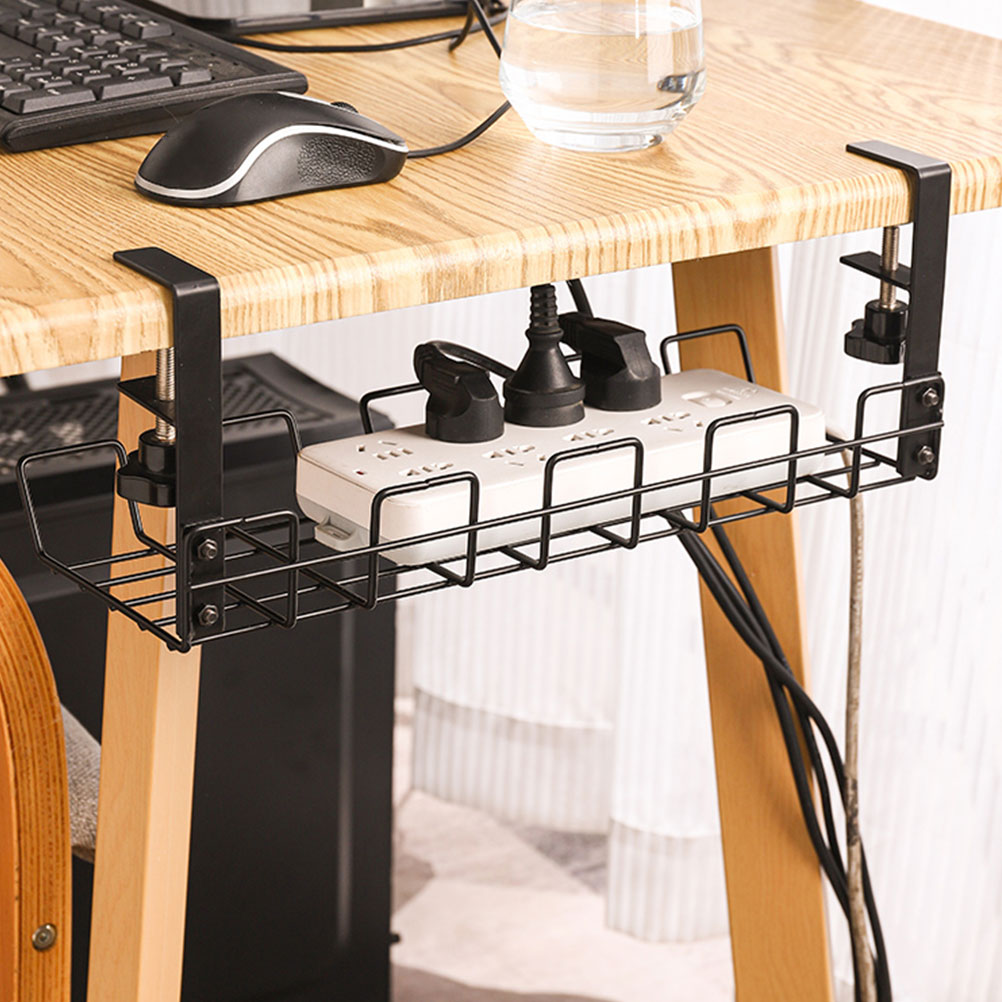
8. Invest in Keyboard Tray or a Monitor Stand
If you're using a desktop computer or PC monitor with a keyboard that takes up a lot of space, a keyboard stand can help you make the most of the desk space.
Another super easy way to free up extra desk space is to place your computer on a monitor stand. You can store other items under your computer. You can buy one or make your own.
Investing in a keyboard tray or a monitor stand can be a game-changer when attempting to organize a desk without drawers.
These space-saving solutions not only declutter your desk and workspace but also enhance ergonomic comfort.
A keyboard tray efficiently holds your keyboard and can neatly slide underneath your desk surface when not in use, freeing up valuable desk space.
A monitor stand elevates your screen to eye level, the best position for your posture, and it also creates room beneath for additional storage.
By utilizing these accessories, you can maximize your desk space, and improve your posture, transforming your drawerless desk into a well-organized and ergonomic workstation.
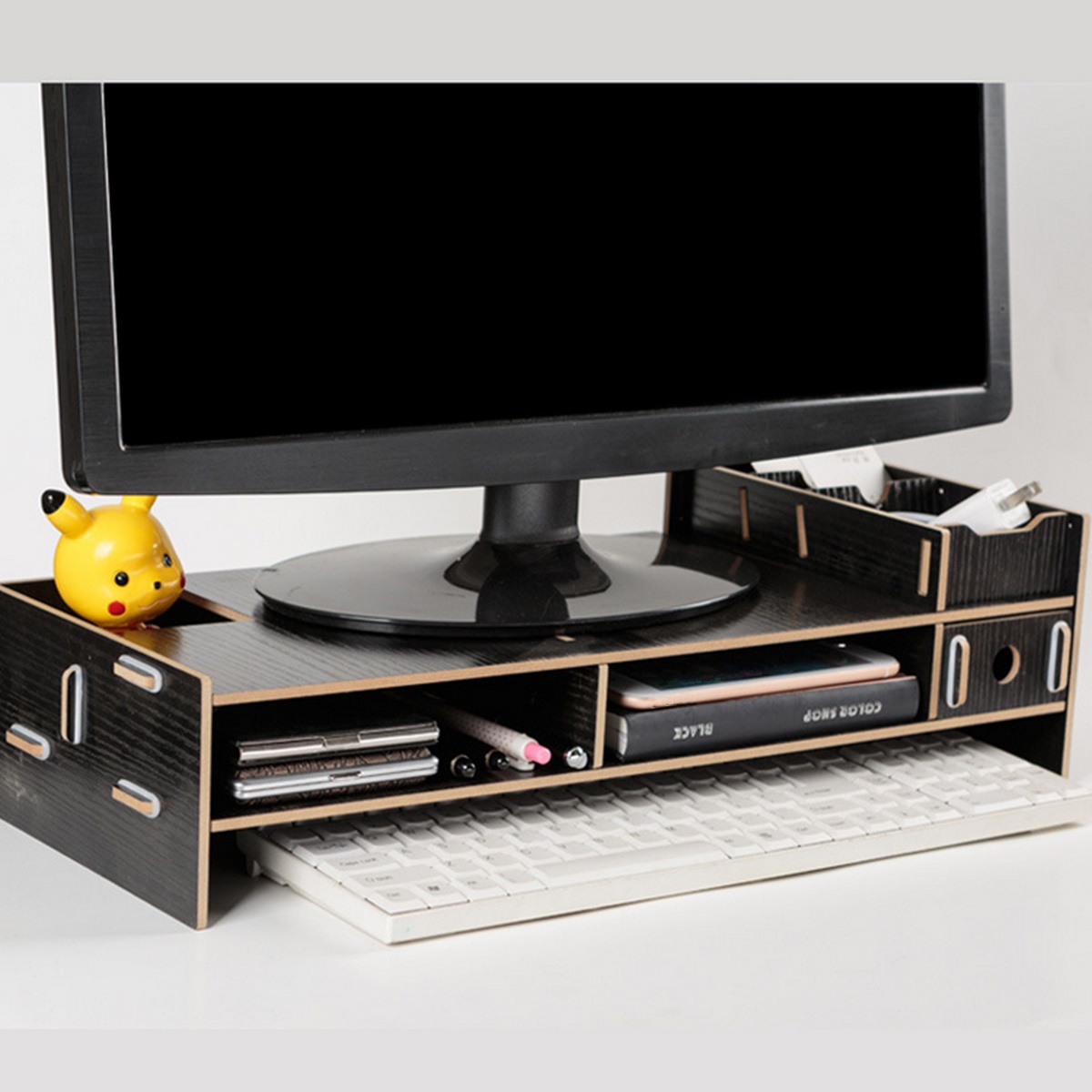
9. Invest in a Storage Cabinet
Another not so cheap way to organize a desk without drawers is to invest in a storage cabinet.
In one of the desk organization techniques, you had to decide which items to keep and which to store away (a few lines above), a storage cabinet is a fine place for those items - remember the urgent but not importnat items? Put them in a storage cabinet.
With its often smart design and practical features, a storage cabinet provides a wealth of options for tidying up your desk essentials.
Its adjustable shelves and spacious compartments offer a designated place for everything, from files and papers to stationery and personal items.
By utilizing the cabinet's various sections, you can create a systematic and efficient organization system tailored to your needs.
The best part is that you no longer have to worry about the mess on your desk, as the storage cabinet keeps everything neatly hidden away, giving your workspace a clean and professional appearance.
Whether you opt for a sleek vertical cabinet that stands beside your desk or a stylish under-desk rolling cabinet, the added storage space will transform your desk area into an organized and efficient workstation, without the need for traditional drawers.
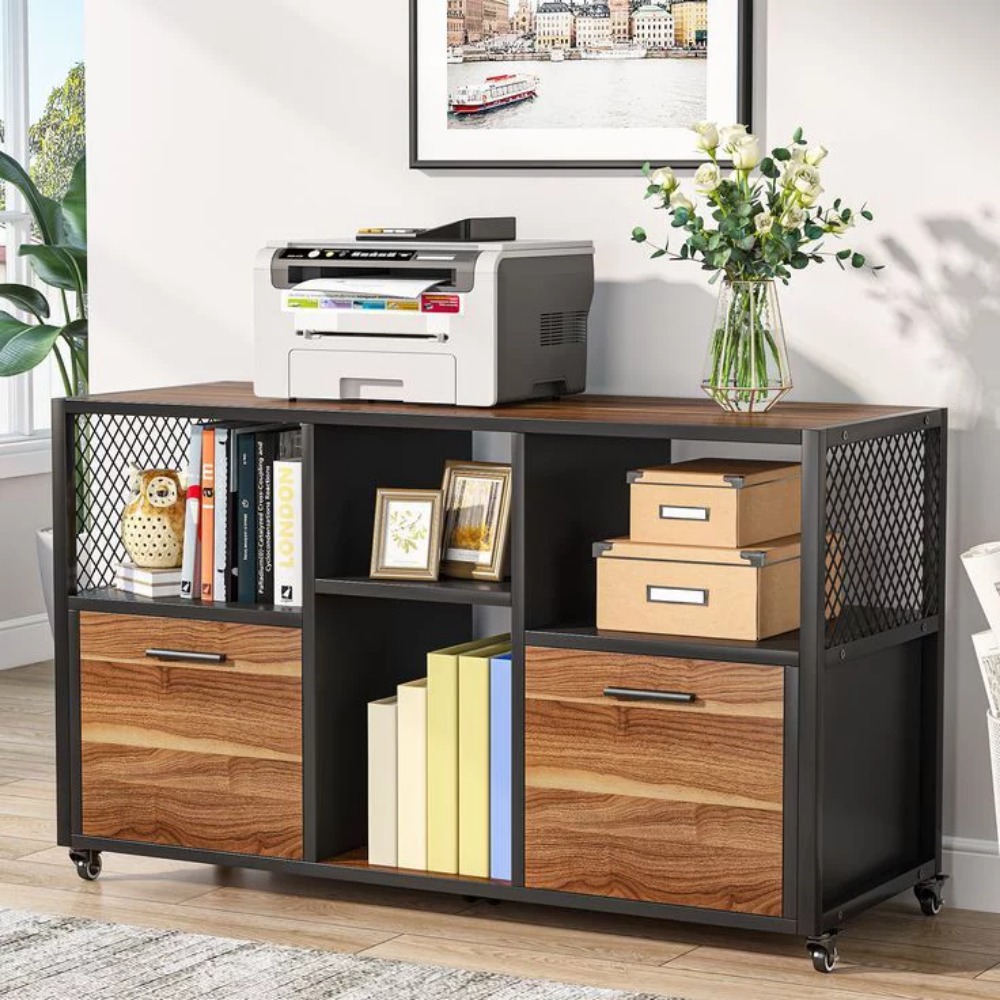
10. Implement a "One In, One Out" Rule
The "One In, One Out" rule is a powerful strategy to maintain an organized and clutter-free desk especially when you have little desk space or a desk without drawers.
Its simplicity lies in the balance it brings to your workspace – for every new item you bring in, you must remove one item that you no longer need. This prevent things from accumulating on your desk.
By adopting this rule, you are forced to be mindful of the items you accumulate and become more conscious of their necessity.
When you receive a new piece of stationery, a gadget, or a decorative item for your desk, take a moment to assess whether it genuinely adds value to your work environment.
Consider whether it serves a practical purpose, brings you joy, or enhances your productivity. If it does, find an item of similar size or category that you no longer use or need.
This could be an old pen that no longer writes well, a piece of outdated office equipment, or a decorative item that no longer resonates with you.
By consistently applying the "One In, One Out" rule, you prevent unnecessary accumulation and keep your desk organized.
You'll find that you become more selective about the items you bring into your workspace, leading to a curated collection of essentials that serve you best.
Additionally, this practice can extend beyond your desk to other areas of your life, promoting a clutter-free and mindful approach to managing your belongings.
As you embrace the "One In, One Out" rule, you'll notice a positive shift in your mindset and productivity.
Your desk will become a space that fosters focus, creativity, and efficiency, free from the burden of excess clutter.
So, the next time you consider adding something new to your desk, remember to make room by letting go of something else.
11. Clean your desk every day
Develop a habit of quickly wiping and cleaning your desk at the end of every work day, especially if your work environment is often messy or dusty.
It's almost impossible to wipe down your desk without taking most things out and then putting them back.
You can organize your things while you wipe. Create a routine to remove unnecessary items from your desk. Just do this once or twice a week so that your desk doesn't become cluttered.
Try to always limit the number of items on your table to the ones you use often.
Tidying up your desk is fine, but let's face it, many of us working remotely are not the best when it comes to time management.
So, cleaning and other household chores are ruled out. Instead, try to plan your cleaning time so that it becomes a part of your routine.
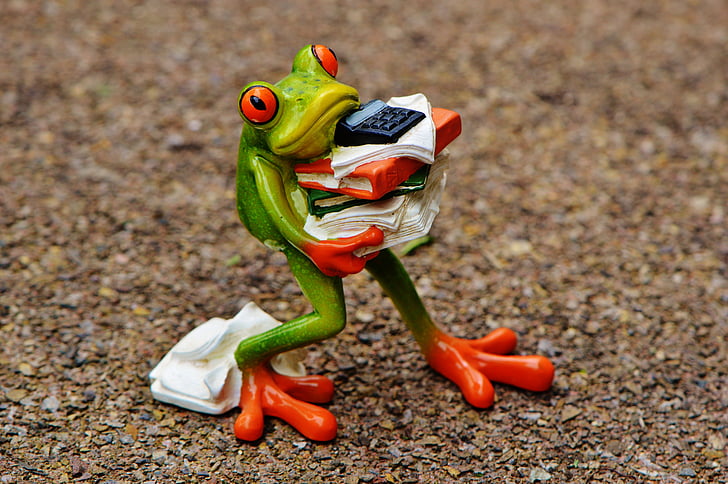
12. Get a Bigger Desk
You might not have enough desk space to organize your desk without drawers because your desk is too small.
Rather than going through the whole process of buying and installing new storage solutions, you can just get a bigger desk.
Most desks are around 120cm long, but adding even 30cm can make a big difference.
How to Keep Your Desk Organized
Now that you know how to organize your desk without drawers, it's important to maintain this new organized desk layout over time.
On a daily basis, start by decluttering your desk before you begin your work. Clear away any unnecessary items, file away documents, and put away any supplies that are not in use.
Throughout the day and at the end of each day, make it a habit to tidy up after yourself and put things back in their designated places.
Set aside some time each week to deep clean your desk. Wipe down surfaces, and dust off electronics. Take this opportunity to re-evaluate your organization system and make any necessary adjustments.
Review and clear out any accumulated paper clutter or outdated files - in case you didn't opt for digitizing them as suggested before.
Dedicate a day each month to tackle more substantial tasks. This might include reorganizing your drawers, archiving or shredding any documents that are no longer needed.
Use this time to check the functionality of your office supplies and replace or restock as necessary.
Lastly, once a year, take a step back and assess your overall workspace setup. Evaluate the layout and ergonomics of your desk, considering improvements that can enhance your comfort and productivity.
Dispose of unnecessary items and optimize your storage solutions. This way you'll always have a well organized and tidy desk.
Common Desk Organization Mistakes to Avoid
When it comes to maintaining an organized and efficient workspace, it's quite common to make mistakes that can quickly lead to clutter and decreased productivity. By avoiding these pitfalls, you can create a more conducive environment for focused work.
1. Ignoring Regular Decluttering:
Allowing clutter to accumulate is one of the most significant mistakes people make. Holding onto unnecessary items, old documents, and broken office supplies not only takes up space but also makes it challenging to find what you need. Regularly declutter your desk by purging items that no longer serve a purpose.
2. Overloading with Stationery:
While having essential stationery is crucial, overloading your desk with pens, pencils, markers, and other supplies can lead to chaos. Limit the number of items you keep on the surface and store surplus supplies in a designated drawer or organizer.
3. Neglecting Cables and Cords:
Messy cables snaking around your desk not only look untidy but can also lead to confusion and even hazards. Invest in cable management solutions to keep cords organized and out of the way.
4. Using Too Many Desk Accessories:
While desk accessories can be helpful, using too many can lead to clutter. Stick to a few practical accessories that serve your needs, such as a pen holder, paper tray, and a small organizer.
5. Placing Unrelated Items Together:
Avoid mixing unrelated items on your desk. Keep personal items, such as photos and mementos, separate from work-related materials. Create designated zones for different types of items to maintain organization.
6. Using the Desk as a Storage Area:
Your desk should primarily be a workspace, not a storage area. Avoid stacking files, papers, or other items on the surface, as this can lead to disorganization and hinder your ability to work efficiently.
7. Choosing Ineffective Organizers:
Not all desk organizers are created equal. Before investing in one, consider your specific needs and find an organizer that suits your work style and workflow.
8. Neglecting Personalization:
While minimalism is excellent for some, neglecting to personalize your desk can make it feel sterile and uninviting. Add a few personal touches to make your workspace feel comfortable and inspiring.
By being mindful of these common desk organization mistakes, you can create a clean, efficient, and harmonious workspace that enhances your productivity and overall work experience.
Bottom Line
Organizing a desk without drawers is possible with a little creativity and determination.
By evaluating your desk space, implementing a desk organization technique, utilizing available storage solutions, maintaining organization over time, and avoiding common desk organization mistakes, you can create a tidy and functional workspace even without drawers.
Don't let the lack of drawers on your desk discourage you from organizing your workspace. With the tips and techniques we have discussed, you can create a workspace that works for you.
What desk organization technique have you used in the past to organize your desk?

Welcome to verywelloffice.com! We are all about helping you keep your workspace healthy and inspiring. Buy our desk organizer, read our informative articles about organizing your desk right, increasing productivity and reducing work stress, and you're all set!
Master the Art of Productivity: Get Your FREE Copy of the Ultimate Guide
Discover proven strategies and practical techniques to skyrocket your productivity. Grab your FREE copy now and supercharge your success!
Created with © systeme.io

